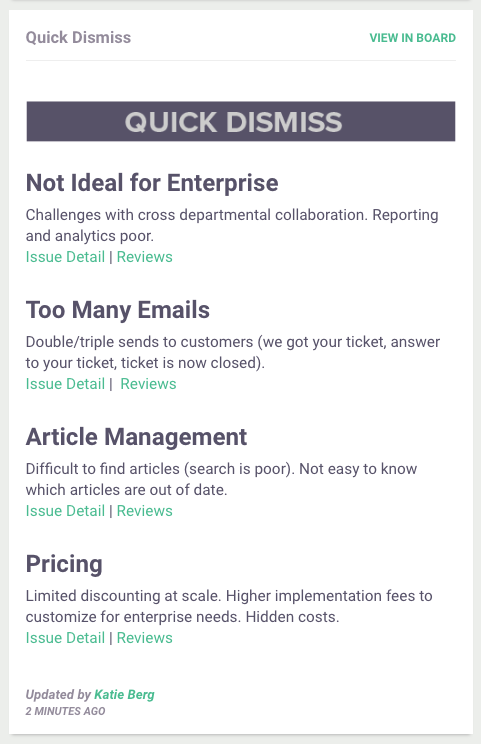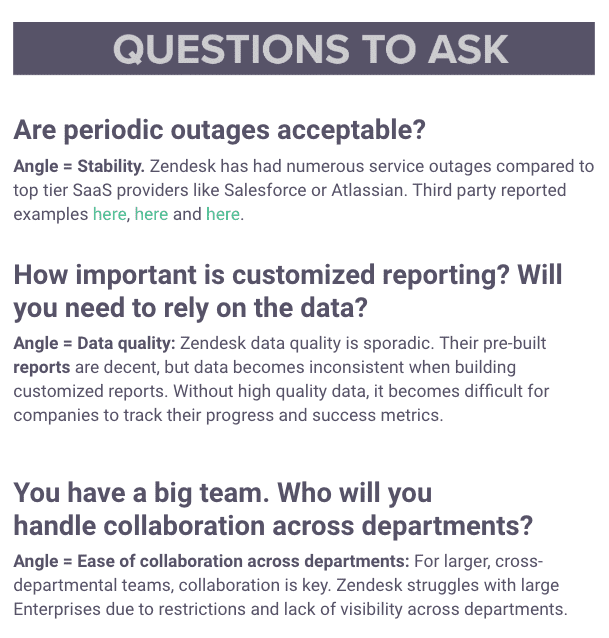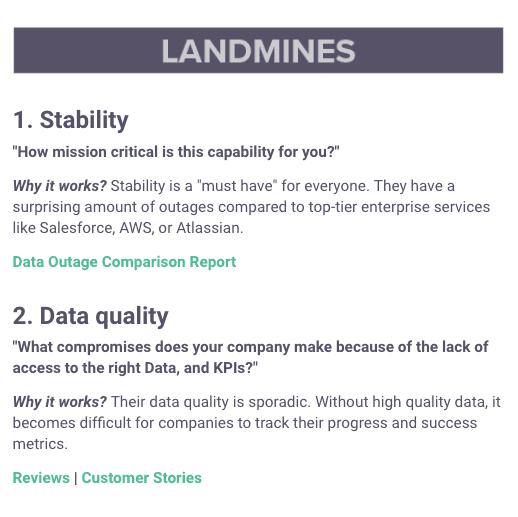Klue Compete
The Competitive Enablement Platform
Learn More
FIND OUT MORE >

One of your salespeople has done it. She’s finally booked a demo with your company’s Dream Customer – tomorrow. Now, it’s time to get your A-game on, fast. Not only is it necessary to prove that you have the best solution, but also that your competitor doesn’t. Without coming across negative.
Positioning your company as the right choice means knowing who you are up against and enabling your salesperson to deposition your competition. As stated in a recent Medium article, “de-positioning [sic] and positioning are NOT opposite sides of a coin; they are simultaneous components.”
Depositioning your competition takes finesse; however, when done well, it can make the rest of the sales process a whole lot smoother and set you up to win. Let’s break it down to help you see how to deposition your competition like a champ.
I’ll admit, the “Rocky” theme song is running through my mind as I write this. And it should be in yours too. This is your Dream Customer! Keep your eye on the prize and never forget that this is a fight. You can bet your competitor will not be holding back any punches so best to beat them to it. Preferably on the first swing. And without drawing blood (more on that later.) OK, enough of the metaphors.
People buy based on emotion, then use logic to justify the decision. Notice I used the word “people”, not customers. So often in the sales process, we tend to unintentionally dehumanize who we are talking about. We use the words prospect, lead, MQL, SQL, and Dream Customer. But they are people first and foremost. Maybe one day we will be selling to AI-powered robots, at which time emotion will play no part. For now, it does.
Emotion-based decision making doesn’t just mean that people buy from which salesperson they like the most. Or even who they have the deepest personal connection with. Emotion in the sales process can also mean buying based on who sold them on a vision; who made it easy to understand the complexities of the solutions they are evaluating.
So, while a critical piece is, listening to your customer and understanding their needs, the bigger opportunity in capturing their emotions, is to make them feel confident in what they buy.
Getting lost in product details and feature functionality makes things complicated. It makes people feel confused and their decision feels riskier; as if they will miss a small detail about a feature and choose the wrong product, disappointing their manger and the rest of their team.
When we haven’t sold our customers on a higher-level vision or made them feel confident that our approach to solving a problem is aligned with their needs, they will more likely turn to logic to make their purchase decisions. This results in side-to-side comparisons of products. Weighted spreadsheets with scores associated with a long list of features between your solution and all of your competitors.
Even if this evaluation does work out for your salesperson in the end, it probably came at a steep discount to close the deal. When we’ve missed the opportunity to position ourselves in the mind of our prospect and make them feel confident in understanding how we are different relative to our competitors we end up in this ugly world of logic and features.
There is no bigger turn off than negativity. We all know that person who is constantly talking trash about other people when they are not in the room. Do you trust them? Not a chance. Since consultative sales is all about building trust, even dipping a toe in negative waters can lead to loss of hard-earned trust.
So, what to do instead?
Stay focused on what your product or service does well. (This is what I mean by not drawing blood — metaphorically). If you’ve done your homework and are confident about the fit of your product over your competitor, then you are in good shape. Stick with your game plan and don’t be tempted into name-calling even if your competitor is. You’ll thank yourself later.
Inevitably though, no matter how strong your salesperson’s connection is, Dream Customer will ask, “how are you different from your top competitor?” This is your chance to get the upper hand. What is said here is critical and will set the tone for the rest of the proceedings.
As mentioned above, never throw your competitor directly under the bus in an attempt to come out on top. Easy enough in theory, but a finer balance in practice.
Here’s a little story about how we approached figuring out how to win at this question.
A little while ago we asked our sales team to record themselves answering the question, “how are you different from your biggest competitor?” It’s a question they answer every day but it was not something that had been scripted for them. The results were eye-opening. The answers were varied and included vastly different statements.
We all agreed, however, that one Account Executive, Erin, had the best answer. She used a formula that made it clear who we are and presented it concisely. It went something like this:
Prospect: “Erin, how are you different from your competitor?”
Erin: “Our products share many similar features, but our companies take different approaches. We look at X as the solution to the problem, whereas they look at Y.”
She followed with two key points to support that statement about how we were differentiating at a product level but stayed out of the nitty-gritty. Then she repeated her initial statement. Closing punch. End of round one.
What was so good about this response? She made it memorable, by repeating the first key statement. And by keeping it high-level she made it easier to understand how we are different from our top competitor.
There is no overt boasting or negative politics. It is a factual statement that allows the other person to make their own decision. Without Dream Customer even realizing it, you have colored the lens from which they will view both you and your competitor moving forward in the sales process. And guess whose side will appear rose-colored?
So you have the ‘Why’ behind depositioning your competition, and the ‘What’ to say. Now, we need to look at ‘How’ to get the rest of your sales team to use this effective product positioning consistently. And, we do this through battlecards.
For a refresher on the basics of battlecards, read Battlecards 101
The further a salesperson gets into a deal, the more information they will need. But they don’t need it all upfront. That will be overwhelming. Instead, you want to present the information in bite-sized pieces and provide it in cascading levels of detail as the sale progresses.
Battlecards help you do this. Each battlecard is a micro-topic containing the most relevant information that Sales can use to help win deals.
Battlecards provide content that will help with either with offensive or defensive strategies. In other words — how to attack my top competitor and how to defend against what they say about us. At all times, but especially early in the deal, it is much better to be on the offensive rather than defensive with your strategy. However, you will always need some combination of offensive and defensive strategies. Today, we are focused on positioning which falls squarely under offensive strategies. Some common battlecards that are effective for positioning are:
Positioning battlecards are a good, basic card to have in your pocket at all times. They should contain content about how your top competitor positions their product or service in the market relative to others. They will contain leading statements and questions that will quickly help your sales team deposition your competition.
From positioning battlecards, your sales team will be able to quickly understand how your competitor’s sales team pitches their product. It should also provide insights into where your competitor’s product is now and possibly where it is heading.
The point of the Quick Dismiss Battlecard is to ask a question that will help knock the competition out quickly. It contains a few main areas that your competition doesn’t do well in. And that you do. See the example below:


Sometimes a prospect will tell you who else they are talking to, but don’t count on it. More often, your salespeople have to listen for clues that indicate which competitor is also in the running. The earlier your reps can identify a competitor in a deal, the better opportunity they have to deposition them.
The questions for this battlecard are meant to expose weaknesses in your competitor’s product or service. For example, if you are selling data storage and you know your competitor has an Achilles heel in the area of security, you might ask: “How important is it for your information to be secure?”


A landmine is used to fully expose a competitor’s weaknesses, so the prospect now has to decide that hopefully will be an obvious choice.
We recommend that you include a list of landmines in the form of questions or statements. The purpose of these questions and statements is not to explicitly call out the competitor, but to provide the prospect with the information necessary to confirm the competitor’s weaknesses.


Following the “How do you compare to your competitor” exercise above, we also included a “What Erin Says” battlecard. (You could do this too, but you will need to use your own “Erin”.) Not only does it help get the team aligned saying the same consistent, effective message, it also gets the competitive juices flowing positively. Never a bad thing for sales teams.
Winning a sales deal is a fight from start to finish. It requires the tricky mix of positioning your product as the right choice while simultaneously depositioning your competition quickly. The good news is, with the right mix of offensive and defensive strategies you can be in control through the process. Your dream customer is a person, connect with them and nurture that relationship. Sell them on a vision to avoid a pricing or feature function negotiation at the end. You are there to provide a solution to their problem and you can help guide them to make the right decision by presenting the right information and the right questions, at the right time. Battlecards are super helpful in communicating and providing the intel needed to win more deals faster and retain happier customers long-term.


Competitive Enablement
The topic of Large Language Models (LLMs) has a lot of confusion. Here's what you need to know about how Klue is working with them.


Competitive Enablement
Product Marketing
If your competitive intel game is too strong for automation, too pure for data privacy, and too rebellious for accuracy — then Klue AI is probably not for you.


Let’s do it. Tell us a bit about yourself and we’ll set up a time to wow you.
Let's do it. Tell us a bit about yourself and we'll set up a time to wow you.
XLet's do it. Tell us a bit about yourself and we'll set up a time to wow you.
XSubscribe to get our latest AI functionality and news in your inbox.
XOur Buyer Pulse feature, set to launch in Q2 2024, offers valuable insights into the factors influencing buyer decisions in your pipeline. By signing up for the waitlist, we can better gauge interest and proactively engage with you to streamline the setup and integration process before the feature becomes widely available.
X